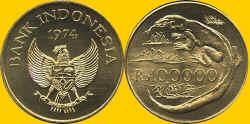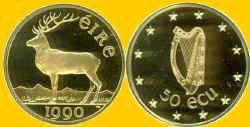This is the Worldwide Numismatics Website!
This is a modest collection of second millennium gold coins
Click the thumbnail picture to see a larger version of the picture, then use your browser BACK button to return to the original page you were viewing.
INDIA
India's first major civilisation flourished for a thousand years from around 2500 BC along the Indus River valley. Aryan invaders swept south from central Asia between 1500 and 200 BC and controlled northern India, pushing the original Dravidian inhabitants south. Alexander the Great's Macedonians made theirs furthest inroads into what is now Indian territory. Egyptians and Romans had trading relations with South India. Moslem invaders took parts of India in the late 12th century AD. In the 17th century, European powers including the British, French, Portuguese, Dutch, and the Danes occupied several cities and set up enclaves on Indian territory. By 1803, the British East India Company had control over most of India. The country gained its independence in 1947m splitting originally into two states, India and Pakistan.
Mints operated on Indian soil from at least 325 BC when Alexander invaded. Literally hundreds of mints operated through history.
1 Mohar - 1202 AH (Yr 19)
KM-103 - 12,36 g - 27 mm
This coin was issued by the British Bengal Presidency under the authority of Emperor Shah Alam and were struck from 1793 to 1818 AD. Both sides have legend using the Arabic alphabet. The date 1202 is seen at the bottom right of the obverse and the regnal year 19 is at the right centre of the reverse.
There are more Indian gold coins in this section if you are interested - Page India 1
INDONESIA
It is generally believed that the earliest inhabitants of the Indonesian archipelago originated in India or Burma. In 1890, fossils of Java Man (homo erectus), some 500,000 years old, were found in east Java. Later migrants ('Malays') came from southern China and Indochina, and they began populating the archipelago around 3000 BC. Powerful groups such as the Buddhist Srivijaya empire and the Hindu Mataram kingdom appeared in Java and Sumatra towards the end of the 7th century. The last important kingdom to remain Hindu was the Majapahit, which was founded in the 13th century. The subsequent spread of Islam into the archipelago in the 14th century forced the Majapahits to retreat to Bali in the 15th century. By this time, a strong Muslim empire had developed with its centre at Melaka (Malacca) on the Malay Peninsula. Its influence was shortlived and it fell to the Portuguese in 1511. The Dutch displaced the Portuguese and began making inroads into Indonesia. The Dutch East India Company based in Batavia (Jakarta) dominated the spice trade and took control of Java by the mid 18th century, when its power was already in decline. The Dutch took control in the early 19th century and by the early 20th century, the entire archipelago - including Aceh and Bali - was under their control and called the Netherlands East Indies. Burgeoning nationalism combined with Japanese occupation of the archipelago during WWII served to weaken Dutch resolve, and it finally transferred sovereignty to the new Indonesian republic in 1949. Achmed Soekarno, the foremost proponent of self-rule since the early 1920s, became the first president.
100.000 Rupiah - 1974
KM-041 - 33,44 g
Edge - Reeded
Mintage - 5.333
This NCLT "coin" was issued in a conservation series. The obverse has the Indonesian arms with the date 1974 above and with BANK INDONESIA around the periphery. The reverse has a komado dragon lizard with the denomination Rp 100000 to the lower right.
IRAN
Elamites were most likely the first organised inhabitants of Persia followed by the Aryans came to the region in the second millennium BC. In the middle of the 6th century BC, the Achaemenian king Cyrus the Great ruled the region and Persian recorded history dates from that time. Alexander the Great invaded Persia in the 325 BC timeframe after conquering most of Greece, Egypt, Turkey and Iraq. defeating Darius III. After the fragmentation of Alexander's empire, Seleucids, Parthians, and Sassanians occupying Persian territory until they were eventually overrun by the Arabs in 637 AD. Arabs ruled until 1050, converting most of the population to Islam and introducing the new Persian script and Islamic culture. They were finally defeated by a Turkish dynasty in 1051. The Turks held sway until they were swept away by Genghis Khan's Mongols in the early 13th century who held power until the late 14th century. The Persian empire flourished in spite of invasions by Afghans and Turks. The last Shah allied himself with the West and, though autocratic, make great strides into bringing Iran into the 20th century. Unrest in 1979, led to his fleeing the country and the mullahs seized power setting up an "Islamic Republic" and reversing much of Iran's advancement to the modern world.
Numerous mints operated from the earliest times through the 18th century.
1 Pahlevi - 1324 SH (1945)
KM-1148 - 8,14 g
This coin was issued under Shah Mohammad Reza Pahlavi (b1919-d1980), the last shah of Iran. The obverse features the royal arms of Iran with a Persian inscription beneath and the date of the Shah's accession. The reverse has a Persian inscription and the date.
There are more Indian gold coins in this section if you are interested - Page Iran 1
IRAQ
Iraq was the cradle of civilisation starting with the Garden of Eden which lore has was located between the Tigris and Euphrates Rivers. The Sumerian culture flourished as early as 4000 BC in this area known as Mesopotamia. These people developed a written language and many relics of that are known today in the form of cuniform clay tablets documenting everything from politics to merchant records as well as early literature. After the collapse of the Sumerian civilization, the people were reunited in 1700BC by King Hammuradi of Babylon (1792-1750 BC), and the country flourished under the name of Babylonia. Hammurabi developed the concepts of law that apply in most civilised countries today. The Assyrians and Chaldeans were other peoples of the area who influenced Babylonia through assimilation and war. Various outside invaders including Cyrus the Great in 539BC and Alexander the Great in 331BC, held sway until the second century BC, when it became part of the Persian Empire, remaining thus until the 7th century AD, when Arab Muslims captured it. Genghis Khan's grandson, Hulagu Khan), marched on Baghdad with two hundred thousand Mongols. The result was bloodshed and ruin. The Mongols remained busy in killing for forty days. Rivers of blood flowed in the streets and all the alleys were filled with dead bodies. Hundred of thousands of people were put to the sword. The Mongol left the countryside totally ruined. While in Baghdad, Hulagu deliberately destroyed what remained of Iraq's canal headworks. The material and artistic production of centuries was swept away andIraq became a frontier province ruled from the Mongol capital of Tabriz in Iran. After much conflict over supremacy, the country was conquered by the Turks in the 17th century and became part of the Ottoman Empire. Turkish rule continued unchecked, and with very little development, until the end of the 19th century. British forces invaded Mesopotamia in 1917 and occupied Baghdad. The country became a British Mandate. Local unrest, however, resulted in an Arab uprising in 1920, and after costly attempts to quell this, the British government decided to set up Iraq a kingdom, under the rule of Emir Faisal, and, although the monarch was elected by plebiscite in 1921, full independence was not achieved until 1932, when the British Mandate was officially terminated. Iraq joined the League of Nations in the October of that year, and was officially recognised as an independent sovereign state. Arab factions, bitterly opposed to the pro-Western stance of the king, staged a military coup in 1958 led by General Karim Kassem. The country was proclaimed a republic.
Many cities minted coins from the earliest days of history.
5 Dinars - 1971
KM-134 - 13,57 g - 28mm
Mintage
- 0,020M
This coin was issued to commemorate the 50th anniversary of the Iraqi Army. The reverse has the denomination in a circle in the centre. At the top is the Arabic inscription for the Iraqi Republic. At the bottom are the dates 1971 - 1395 with an Arabic inscription denoting the event. The reverse pictures two soldiers, the one at the top from 1921 with that date to the right and the second from 1971 with that date to the left.
IRELAND
50 Ecu - 1990
KM-134 - 13,57 g - mm
Mintage - 5.000
This NCLT "coin" was issued to commemorate Ireland's tenure in the European Community Presidency for the first six months of 1990. The obverse features the Irish national emblem, a harp, surrounded by twelve stars enumerating the member states of the EU. The reverse has an Irish Red Deer with the denomination with the country's name EIRE and the date 1990.
If you would like to see additional gold coins, please click here - Page 17
If you want to return to the home page, please click here - Home

